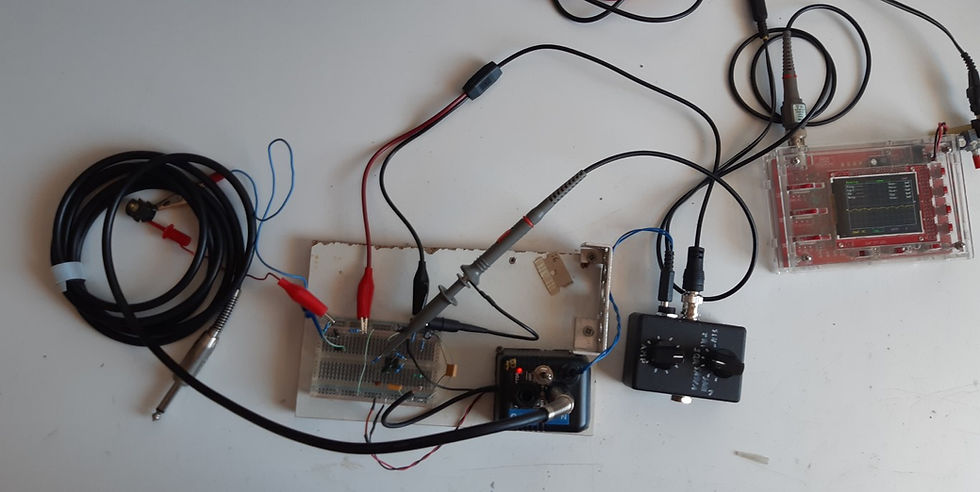Cable shielding tester
- bentfishbowl
- May 27, 2023
- 3 min read
Updated: May 28, 2023
There are times when instrument cables let through an unacceptable amount of interference, usually from mains. It could be a faulty cable because of mechanical strains, or a cable that was never good to begin with. With most people the cable gets disposed of, but could there be more to check? What if you don't want to rely on your ears and the presence of substantial interference to find the problem? What if the interference is actually caused by something else?
Well, it would be nice to have a simple setup to quickly check many cables with then, maybe not a very professional one but good enough for the purpose. That's why I've made and tested the following circuit.

The concept is very simple: a coil is driven from a square wave by a small MOSFET and placed close to the cable; one end of the cable is plugged into a high impedance buffer followed by a second order high-pass filter. The output of that is connected to a scope (alternatively a phone or audio interface).
The test signal is provided by my new signal generator, which can do a large ~600 Hz square wave among other things. The exact frequency isn't important, but it should be high enough to be easily separable from the inescapable mains hum and to use inductors of a sensible size. You can probably use any device capable of outputting audio, as long as you amplify the output with something like a common emitter, or build a dedicated oscillator with either a dual op-amp or a 555.
The inductor I'm using comes from a broken wah pedal I was gifted. It doesn't really matter what kind it is, as long as the inductance is high enough and it's not very well shielded. You can probably use some transformers too. You could probably also connect the driver to the output jack of your electric guitar or bass if you have one, and use the pickups as radiators, but I'm not responsible if you try that.
One problem I was facing at first was that it was hard to see anything that wasn't just mains hum on the output. Thankfully, a simple second-order Sallen-Key high-pass filter tuned just below the test frequency helped immensely. Of course, if you use a different test frequency, the filter would have to be scaled accordingly, while keeping the same ratios. The input for the filter is buffered, and this allows also to change the loading on the cable.
In my case, the output is connected to my oscilloscope with AC coupling. You might want a coupling capacitor there otherwise.
My setup looked like this. It can probably be improved but it was fine for testing the idea. Things like separation between the driver portion and the receiver and shielding the connection between the cable and the op-amp input are important, and this setup is a fair attempt at that. I've even tried to cover the breadboard with an old pan I had turned into a "breadboard shield" by adding a wire to, but it didn't make much of a difference.

Here are the results for three very different cables: an unshielded footswitch cable, a well made but faulty instrument cable, a cheap working instrument cable (the one in the picture above).
I've repeated the test with many other cables, some seeming slightly better than others, but none was even close to the faulty cable.
Of course this rough-and-ready test isn't very rigorous, but it could be more so with some precautions: fixing the inductor in place, placing the cable always at the same distance... If one wishes for the test to be more sensitive, it's possible to simply increase the gain of the first op-amp stage.
Another thing to keep in mind is that if the cable is coiled around the inductor, it will pick up the signal more easily the more turns it makes: the faulty cable is barely a meter long and only made a single turn, so it was at an advantage. It's probably also possible to do some more localized tests by uncoiling the cable and sliding it against the inductor, to see where the shielding is weakest. It's also worth to test both ends plugged into the receiver, in case the shielding is connected better to one end than the other.
I admit that this project is a bit outside what I'm most confident with, so I'll appreciate and collect any feedback about eventual stupid mistakes before making a more definitive form of this.






notice me senpai